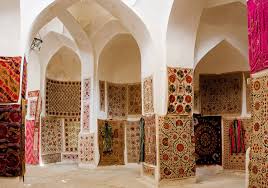Eng: Tim

Tavsif
Usti yopiq bozor, savdo rastasining baland tomi, gumbazi. Timlar qadimda asosan yirik shahar markazlarida, koʻchalar kesishgan chorraha, chorsu, guzar maydonida, karvonsaroylar yaqinida joylashgan. Usti ulkan gumbaz bilan qoplanib, bir necha hunarmandlik doʻkonlari va savdo rastalarini oʻz ichiga olgan. Timlar shahar meʼmoriy qiyofasini belgilashda muhim ahamiyatga ega boʻlgan.
Description
Covered market, high roof of the trading floor, dome. In ancient times, tims were located mainly in large city centers, at intersections, bazaars, guzar squares and near caravanserais. It is covered with a huge dome and includes several craft shops and stalls. Tims have played an important role in shaping the city's architecture.
Misol(lar)
|
Toqi Zargaron ostidagi odamlar g‘ujg‘on urgan bozorga kirar, salqin timlar ostidan o‘tib, limillab turgan Toshhovuz labida bir lahza nafasini rostlab olardi. Manba: Mirmuhsin, Me’mor |
|
Ertasi kuni, darhaqiqat, Bozori Qandahorda, tim ichida еalaba paydo bo‘lib, u etik xarid qilish bahonasi bilan Farmon kal do‘koniga kirib, kursiga o‘tirdi. Manba: Mirmuhsin, Me’mor |
Example(s)
|
The people under Toqi Zargaron would enter the bustling bazar, pass under the cool tims, and catch their breath for a moment on the side of Dashhovuz. Manba: Mirmuhsin, Architect |
|
The next day, indeed, in Bazar Kandahar, a student appeared in the tim, and under the pretext of buying shoes, he entered the Farmon Kal’s store and took a seat. Manba: Mirmuhsin, Architect |